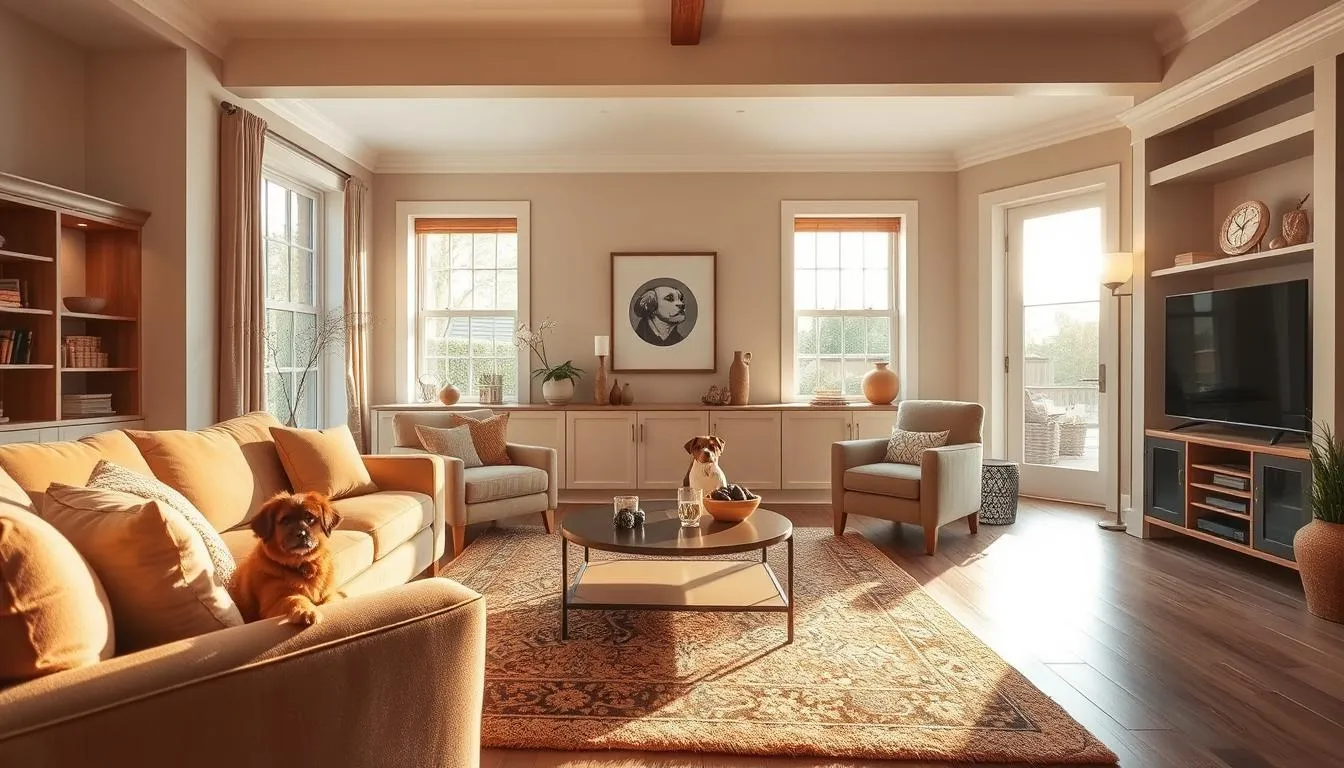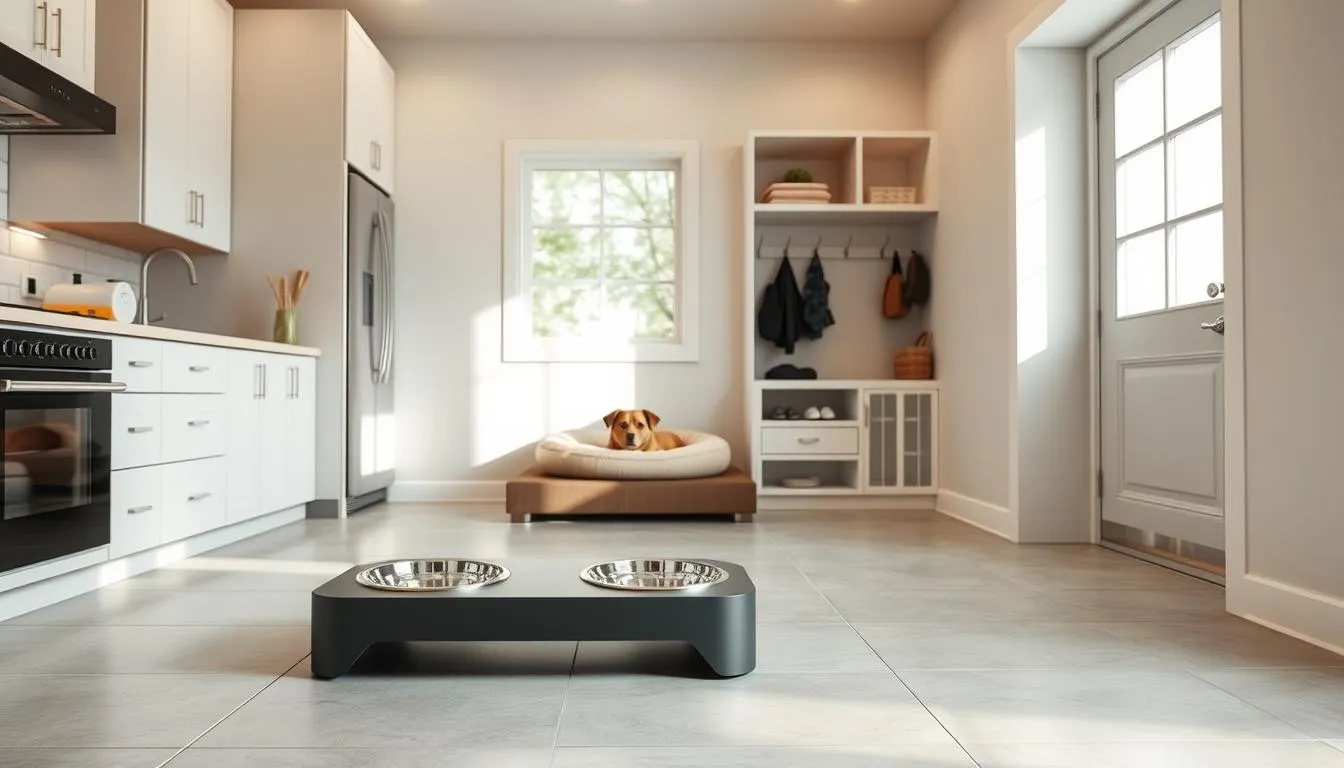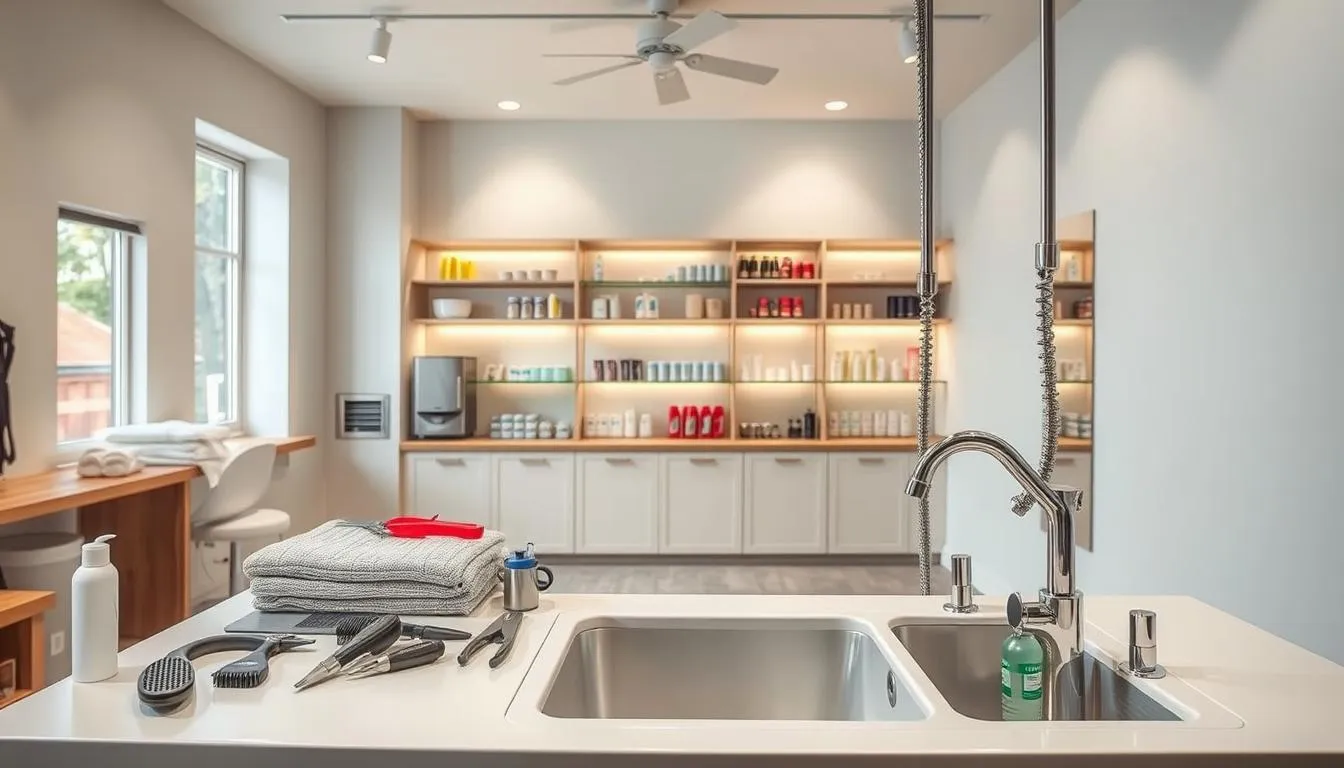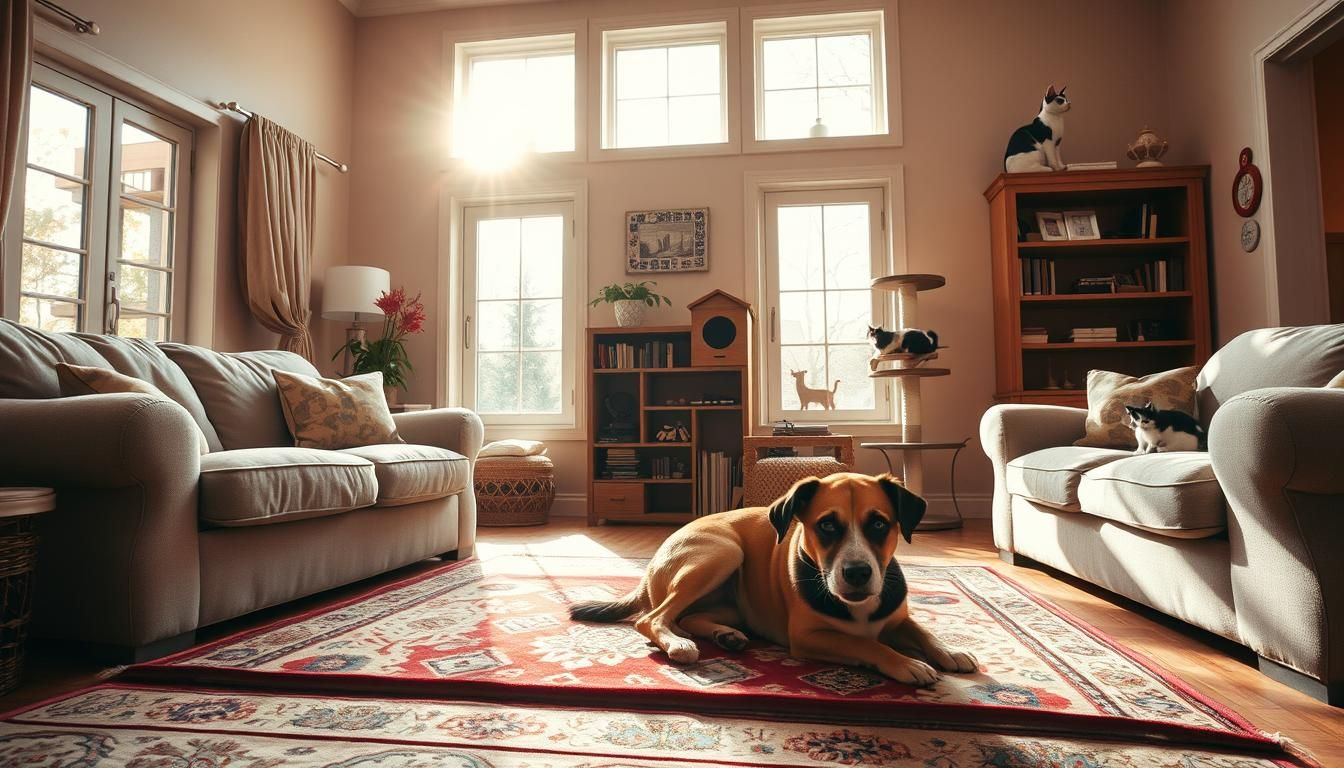There are moments when your home feels both loved and crowded. You want a stylish home that works for everyone who lives there. That includes small family members who track in mud and need quiet corners.
Thoughtful design can make daily routines easier. Built-in feeding nooks, pull-out storage with airtight bins, and hidden litter solutions keep clutter at bay. Durable finishes like quartz counters, luxury vinyl, porcelain tile, and bamboo flooring stand up to busy life. For enhanced functionality, Choose pet-safe materials from durable sustainable flooring choices.
In the pages ahead, well explore kitchen feeding zones, mudroom storage, dog-washing stations, and access solutions that blend form and function. Homeowners choose these upgrades to reduce mess, save time, and raise the quality of home design. With a bit of planning, your remodel can create calm traffic flow, boost safety, and make chores feel simpler. For enhanced functionality, Create calm spaces using noise-reducing materials for pets.
Key Takeaways
- Smart upgrades marry beautiful design with everyday function.
- Built-in bowls and airtight storage cut clutter and odors.
- Dedicated grooming zones and low-entry wash areas simplify care.
- Durable materials like quartz and luxury vinyl protect surfaces.
- Plan for traffic flow and safety to make spaces work for all members. For enhanced functionality, Design pet-friendly areas with indoor-outdoor living transitions.
Designing for Pets and People: Why Pet-Centric Remodels Matter Right Now
Design that anticipates movement and mess turns common areas into calm, usable rooms for everyone. A design-led plan aligns traffic patterns, access, and storage with daily routines so feeding, grooming, and comings and goings are smoother.
Integrated solutionslike Dutch doors, pocket half-doors, and built-in pulloutsreplace clunky gates and visible bins. These features keep bowls and litter tucked away and maintain a cohesive interior. Better Homes & Gardens provides expert guidance on creating pet-friendly spaces that maintain style and function.
Easy-to-clean surfaces, careful outlet placement, and slip-resistant finishes protect health and preserve finishes. That means less stress for family members who feed, walk, and care for animals.
“Small, smart upgrades can transform a projects function and increase its long-term payoff.”
- Control access without clutter.
- Reduce bottlenecks near doorways and feeding spots.
- Protect surfaces and improve hygiene.

| Solution | Benefit | Common Placement |
|---|---|---|
| Dutch / pocket doors | Discrete access control | Entryways, mudrooms |
| Hidden feeding & litter cabinets | Less clutter, odor control | Kitchen islands, hall cabinets |
| Non-slip grooming areas | Safety and easy cleaning | Laundry, bathrooms |
Smart Kitchen, Laundry, and Mudroom Upgrades for Everyday Ease
A few smart tweaks to your kitchen, mudroom, and laundry can turn messy routines into fast, calm tasks.
Built-in feeding stations belong in toe-kicks, islands, or lower cabinets where bowls stay out of the traffic path. This keeps the dining area tidy and reduces trip hazards.

Built-in feeding stations that keep bowls tidy and off the traffic path
Locate a feeding station in the kitchen or mudroom so the bowl stays put and cleanup is simple. A recessed bowl with a dedicated spigot cuts spills and speeds refills.
Pullout storage for kibble, treats, meds, and leashes with airtight bins
Map a pullout next to the feeding area with airtight bins to keep food fresh and pest-free. Full-extension drawers and clear acrylic bins make leashes, meds, and treats easy to find.
Hidden litter solutions that blend into cabinetry and control mess
Integrate a litter cabinet into base cabinets with side or back cutouts. Venting and discreet doors keep odors and scatter under control while preserving interior flow.
- Place a feeding station in the kitchen or mudroom for smoother traffic and easy cleanup.
- Add a dedicated water spigot and recessed bowl to cut spills.
- Use labeled full-extension drawers and airtight bins for food and supplies.
- Consider a pocket half-door to manage access in busy spots.
For more detailed layout tips and product picks, see our This Old House.
Bath Time Made Easy: Grooming Stations That Tame the Mess
A well-planned grooming station turns messy bath time into a calm, efficient routine. Design matters: place the station near plumbing and a door to limit wet traffic through the home.

Low-entry showers and raised platforms
Plan a low-entry shower with a shallow threshold so older dogs can step in without stress. Add a raised bench or platform to protect your back and speed rinses.
Handheld sprayers and nearby hooks
Choose a handheld sprayer with variable pressure to rinse thick coats quickly. Install hooks and open cubbies for towels, leashes, and brushes within arms reach.
Safe flooring and water-resistant finishes
Specify nonslip flooring and water-resistant wall and cabinet materials to handle splashes. Good drainage and splash guards keep the surrounding room dry and durable. The Kitchn offers practical ideas for designing grooming stations and pet-friendly bathrooms.
Drying alcoves and tidy storage
Include a drying alcove or built-in dryer to contain shake-offs and speed drying. Tuck closed storage into the station for shampoos and tools so the area stays uncluttered.
- Low curb or curb-free shower for easy access
- Raised platform to reduce bending and speed bath time
- Handheld sprayer, hooks, and built-in storage for fast workflow
petfriendly renovation ideas for Access, Comfort, and Safety
A few strategic doors, gates, and tucked-away nooks let homeowners balance safety, flow, and comfort.
Stylish gates and Dutch doors that control entry
Choose Dutch doors or pocket half-doors with metal rails to prevent scratches and slide cleanly into the wall. These built-ins manage pet access without cluttering paths.
Cozy caves and nap nooks under benches
Carve a dog cave beneath a bench, island, or open cabinet base. It gives your dog a quiet spot near the action without blocking walkways.
Custom pet doors: insulated and automated
Install insulated or automated pet doors to balance security, energy efficiency, and controlled pet access. Automation keeps wildlife out and gives owners peace of mind.
Entryways built for wipe zones and gear
Design the entry area with wipe mats, hooks, and trays. Use durable, easy-clean finishes in this high-traffic area to keep mud and wet gear contained.
| Feature | Benefit | Typical placement |
|---|---|---|
| Pocket half-door | Discrete access control | Hallways, mudrooms |
| Dog cave under bench | Cozy resting spot | Kitchen island, entry bench |
| Insulated/automated door | Security and efficiency | Exterior walls |
Durable Materials and Finishes That Stand Up to Real Life
Choose durable finishes that take daily wear in stride and keep your interior looking newer, longer.
Flooring picks matter. Luxury vinyl, matte porcelain tile, and strandwoven bamboo resist scratches and handle moisture while staying comfortable underfoot.
For kitchen worktops, quartz is a top choice. It wipes clean, resists stains, and holds up to heavy use without etching.
Waterresistant cabinet finishes near sinks and feeding areas stop swelling and peeling from drips. Pair them with rounded edge profiles and durable hardware to tolerate bumps from active dogs and carriers.
- Use sealed grout and tight transitions to protect subfloors from water seepage.
- Favor matte or lowsheen textures to hide fur and smudges while fitting broader home design.
- Plan storage near highuse zones so cleaning supplies and care items stay within reach.
Balance durability with style by selecting a cohesive palette and finishes that elevate the space while minimizing upkeep during daily life and remodeling projects.
Pet-Friendly Renovation Cost Breakdown and Budget Planning
Understanding costs upfront helps homeowners plan phases and prioritize high-impact improvements. Pet-friendly renovations range from simple DIY projects to comprehensive remodels involving multiple contractors.
Essential Project Cost Ranges
Built-in feeding stations typically cost $300-$800 for DIY installations, while custom cabinetry solutions range from $1,200-$3,500 including professional installation. The investment pays off through reduced cleanup time and improved kitchen organization.
Pet washing stations vary significantly by scope. A simple mudroom sink conversion costs $800-$2,000, while a full dog wash room with custom tile, drainage, and ventilation ranges from $5,000-$15,000.
Flooring upgrades depend on square footage and material choice. Luxury vinyl plank costs $3-$8 per square foot installed, while porcelain tile ranges $8-$15 per square foot. For a 200 square foot area, expect $1,600-$3,000 total.
Professional vs. DIY Considerations
Electrical work for pet doors, lighting, and outlets requires licensed contractors. Budget $150-$300 per outlet and $400-$1,200 for pet door installations with electrical components.
Plumbing modifications for wash stations cost $200-$500 per fixture for basic connections, while complex drainage and hot water lines can reach $1,500-$3,000.
Custom cabinetry and built-ins offer the best integration but require skilled carpenters. Expect $200-$400 per linear foot for custom work, compared to $50-$150 for modified stock cabinets.
| Project Type | DIY Range | Professional Range | ROI Potential |
|---|---|---|---|
| Feeding station | $300-$800 | $1,200-$3,500 | High convenience value |
| Wash station (basic) | $500-$1,500 | $2,500-$8,000 | Moderate to high |
| Flooring (200 sq ft) | $800-$2,000 | $1,600-$3,000 | High durability value |
| Pet doors (automated) | $200-$600 | $800-$2,000 | High convenience |
Financing and Phased Implementation
Start with high-impact, low-cost improvements like feeding stations and storage solutions. These deliver immediate benefits while you save for larger projects like flooring or wash stations.
Home equity lines of credit often provide favorable rates for renovations that add functional value. Many contractors offer financing for projects over $3,000.
Phased timelines work well for pet owners. Complete one area at a time to minimize disruption to pet routines and allow for budget recovery between phases.
Advanced Pet-Friendly Features for Modern Homes
Today’s pet owners expect sophisticated solutions that blend seamlessly with contemporary design. Smart technology and innovative materials create possibilities that weren’t available even five years ago.
Smart Home Integration for Pet Care
Automated feeding systems connect to smartphone apps, allowing precise portion control and feeding schedules. Premium models ($200-$800) include cameras and portion tracking for multiple pets.
Smart pet doors with RFID or microchip activation prevent wildlife intrusion while providing secure access. Installation costs $400-$1,200 but offers peace of mind and energy efficiency.
Monitoring cameras designed for pet areas help owners check on pets remotely and can alert to unusual activity. Indoor models start at $100, while outdoor-rated versions cost $200-$400.
Climate Control Considerations
Zone heating and cooling benefits homes with pets by maintaining consistent temperatures in pet areas while saving energy in unused spaces. Smart thermostats ($150-$400) learn pet and family schedules.
Air purification systems specifically designed for pet dander and odors range from $300-$1,500. HEPA filters and UV-C sanitizers provide comprehensive air quality improvement.
Humidity control becomes crucial in pet wash areas. Exhaust fans ($100-$400) prevent moisture buildup, while whole-house humidification systems ($1,500-$3,500) benefit pets with dry skin conditions.
Innovative Storage Solutions
Hidden litter systems now include odor-elimination technology and self-cleaning mechanisms. Premium installations cost $1,500-$4,000 but virtually eliminate daily maintenance.
Toy and supply organization extends beyond simple storage. Custom drawer systems with dividers, label systems, and easy-clean materials help maintain organization long-term.
Mudroom command centers combine pet gear storage with family organization needs. Digital displays, charging stations, and weather alerts create functional entryway hubs.
Material Innovation and Durability
Antimicrobial surfaces in feeding and washing areas provide ongoing protection against bacteria and odors. Copper-infused materials and specialty coatings add 15-30% to material costs but reduce long-term maintenance.
Self-healing flooring technologies resist scratches and scuffs from pet claws. While premium options cost 20-40% more than standard materials, they maintain appearance longer.
Stain-resistant textiles for pet areas use nanotechnology to repel liquids and odors. These materials cost more upfront but reduce replacement frequency and professional cleaning needs.
Health and Safety Considerations for Pet-Friendly Homes
Creating safe environments protects both pets and family members while supporting long-term home value. Understanding health impacts helps prioritize improvements and materials.
Indoor Air Quality Management
Ventilation improvements become critical in homes with pets. Pet dander, odors, and allergens require enhanced air circulation. Energy recovery ventilators ($1,200-$3,500) provide fresh air without energy penalties.
Low-VOC materials matter more in pet households because animals spend more time at floor level where off-gassing concentrates. Choose zero-VOC paints, adhesives, and sealers even if they cost 20-30% more.
Allergen reduction strategies include washable window treatments, hard surface flooring, and regular duct cleaning. Professional duct cleaning costs $300-$500 but significantly improves air quality.
Chemical Safety and Material Selection
Pet-safe cleaning products should guide material choices. Sealed surfaces that clean easily with mild detergents reduce the need for harsh chemicals. Natural stone may require sealing ($3-$5 per square foot) but provides chemical-free cleaning.
Plant selections in integrated designs must avoid toxic varieties. Safe options include spider plants, Boston ferns, and bamboo palms. Toxic plants like lilies, azaleas, and philodendrons must be avoided entirely.
Water quality concerns in pet washing areas may require filtration systems. Basic filters cost $100-$300, while whole-house systems range from $1,500-$4,000.
Emergency Preparedness Integration
Pet evacuation planning should influence renovation decisions. Wide doorways, accessible storage for carriers and supplies, and multiple exit routes support emergency readiness.
First aid accessibility in pet areas includes cabinet space for medical supplies, good lighting for examinations, and easy-clean surfaces for treatment areas.
Utility shutoffs should be clearly marked and accessible during pet-related emergencies. Gas, water, and electrical shutoffs near pet areas require clear labeling and easy access.
Regional Considerations and Climate Adaptations
Local climate and regulations significantly impact pet-friendly renovation choices and costs. Understanding regional factors helps optimize designs and avoid costly mistakes.
Cold Climate Adaptations
Heated entry mats ($200-$600) prevent ice buildup and provide comfort for paws. These systems integrate with mudroom designs and reduce tracking of salt and ice.
Insulated pet doors become essential in northern climates. Triple-sealed designs ($400-$1,200) prevent heat loss while maintaining pet access. Some models include programmable lockouts during severe weather.
Radiant floor heating in pet areas provides consistent warmth for arthritic animals. Installation costs $8-$15 per square foot but offers excellent comfort and energy efficiency.
Hot Climate Considerations
Cooling stations for pets include elevated beds, shade structures, and even misting systems. Basic installations cost $300-$1,000, while integrated systems with timers and sensors reach $2,000-$5,000.
Heat-resistant materials become crucial in sun-exposed areas. Light-colored surfaces, UV-resistant finishes, and heat-reflective materials prevent burns and reduce cooling costs.
Ventilation enhancements in hot climates focus on air movement and heat extraction. Whole-house fans ($800-$2,500) and enhanced attic ventilation ($500-$1,500) improve comfort.
Humidity and Moisture Management
Dehumidification systems in humid regions prevent mold and odor issues. Whole-house systems cost $1,500-$4,000 but protect both pets and structural integrity.
Moisture barriers under flooring and behind walls prevent damage from accidents and humidity. Premium installations add $2-$5 per square foot but provide long-term protection.
Drainage improvements around homes prevent water infiltration that creates unhealthy conditions. French drains and improved grading cost $3,000-$10,000 but protect foundation and air quality.
Maintenance Schedules and Long-Term Care
Proper maintenance protects renovation investments and ensures pet-friendly features continue functioning optimally. Establishing routines prevents small issues from becoming expensive problems.
Daily and Weekly Tasks
Feeding area maintenance includes wiping surfaces, emptying water bowls, and checking for wear. Use pet-safe cleaners and inspect seals around built-in features weekly.
Floor care routines vary by material but generally include daily sweeping of pet areas and weekly deep cleaning. Luxury vinyl requires different care than porcelain tile or natural stone.
Air filter changes become more frequent in pet households. Check filters monthly and replace every 30-60 days depending on shedding seasons and air quality needs.
Monthly and Seasonal Maintenance
Pet door servicing includes cleaning sensors, checking seals, and testing electronic functions. Replace batteries in smart doors and inspect weather stripping quarterly.
Wash station deep cleaning involves descaling showerheads, cleaning drain strainers, and inspecting caulk and grout. Address minor issues immediately to prevent major repairs.
Storage organization requires periodic decluttering and cleaning. Rotate toys and supplies, check expiration dates on food and medications, and clean containers thoroughly.
Annual Professional Services
Deep cleaning services for pet households cost $200-$500 annually but maintain hygiene and protect investments. Professional equipment removes embedded odors and allergens.
System inspections for HVAC, plumbing, and electrical components ensure pet-related additions function safely. Budget $300-$600 annually for comprehensive inspections.
Material assessments help identify wear patterns and plan replacements. Early identification of failing caulk, flooring, or fixtures prevents water damage and expensive repairs.
Conclusion
Comprehensive pet-friendly renovations create lasting value through thoughtful planning, quality materials, and professional execution. Start by anchoring projects in high-use areas like kitchens and mudrooms where built-in feeding stations, storage solutions, and easy-clean surfaces deliver immediate benefits.
Prioritize envelope improvements first - choose durable flooring like luxury vinyl or porcelain tile, pair quartz counters with water-resistant cabinet finishes, and invest in proper ventilation to manage humidity and odors.
Add access control through pocket half-doors or Dutch doors, then incorporate dedicated washing areas with low-entry showers, handheld sprayers, and proper drainage. Smart home integration enhances convenience through automated feeding, climate control, and monitoring systems.
Budget $5,000-$15,000 for basic renovations, $15,000-$35,000 for comprehensive makeovers including flooring, cabinetry, and wash stations. Phase projects to spread costs and minimize disruption to pet routines.
Document improvements for resale value, maintain systems regularly, and plan for climate-specific needs. These investments create healthier environments for pets and families while protecting property values through thoughtful, durable design solutions.
FAQ
What are the most cost-effective ways to add a built-in feeding station to my kitchen or mudroom?
Install a recessed cabinet or drawer with removable, stainless steel bowls set at a comfortable height. Add pullout waste bins beneath for easy cleanup and use airtight containers nearby for food storage. Keep the station away from main walkways so bowls don’t block traffic and consider a mat or water-resistant flooring to protect the surface.
How do I create a water bowl filling station that stays clean and sanitary?
Add a dedicated spigot or small faucet at counter height with an easy-drain sink or basin. Use smooth, nonporous materials like quartz or porcelain for the surrounding surfaces to prevent staining. Install a hose or flexible spout for quick rinses and position the station near plumbing runs to reduce remodel cost and complexity.
What storage solutions work best for food, treats, meds, and leashes?
Use pullout drawers with labeled airtight bins for kibble and treats to keep food fresh. Include a smaller, lockable compartment for medications and a wall-mounted organizer or pegboard for leashes, harnesses, and collars. Place these near an entry or mudroom to streamline walks and reduce clutter in living areas.
How can I hide a litter box so it blends with cabinetry and controls odor?
Build a cabinet with a discreet front opening or sliding door and line the interior with washable, waterproof materials. Add a ventilation fan or charcoal filter to control odor and a removable tray for simple scooping. Position the unit in a laundry area or hallway niche with easy access for cleaning.
What features make a grooming or bath station practical for dogs and cats?
Include a low-entry or ramp approach, a raised platform with nonslip surface, and a handheld sprayer for controlled rinsing. Add built-in towel hooks, drying alcoves with airflow, and waterproof storage for shampoos and brushes. Durable, water-resistant flooring and quick-drain solutions help prevent water damage.
Which flooring materials balance durability, comfort, and easy maintenance?
Luxury vinyl plank, porcelain tile, and strand-woven bamboo are strong choices. They resist scratches, handle moisture well, and clean easily. Pair these with area rugs that have non-slip backing to add comfort for family members and reduce noise from nails.
How can I control pet access between rooms without sacrificing style?
Use stylish gates, half-Dutch doors, or slide-away screens to separate spaces while maintaining airflow and sightlines. Built-in dog gates under benches or at short staircases keep traffic smooth. Choose finishes that match your home so these solutions feel integrated, not like an add-on.
Are automated pet doors worth the investment for exterior access?
Automated, insulated pet doors add convenience and energy efficiency, especially in climates with temperature extremes. They offer programmable access and can be paired with microchip readers for safety. Upfront cost is higher, but they save time and reduce wear on interior doors over the long term.
What should I consider when designing a wipe zone at the entry for muddy paws and gear?
Create a dedicated entry with durable flooring, a recessed mat area, and built-in hooks or cubbies for leashes and coats. Provide a bench with storage for boot trays and washable mats. Include a small hose or wipe station if you frequently deal with excessive mud or water after walks.
How do I plan pet access during an overall remodel to minimize disruption?
Set up temporary living spaces with comfortable bedding, separate feeding stations, and play areas away from construction zones. Stage work in sections to keep at least one quiet area available. Coordinate with contractors about work hours and use pet gates to prevent accidental escapes or stress from heavy equipment.
What smart home features work best for pet-friendly renovations?
Automated feeding systems with smartphone controls, smart pet doors with microchip activation, and monitoring cameras designed for pet areas offer excellent convenience and security. Smart thermostats help maintain consistent temperatures while air quality monitors track allergens and odors in real-time.
How much should I budget for a comprehensive pet-friendly renovation?
Basic improvements (feeding stations, storage, minor flooring) typically cost $5,000-$15,000. Mid-range renovations including wash stations and built-ins range $15,000-$35,000. Premium makeovers with custom cabinetry, advanced systems, and high-end finishes can reach $35,000-$75,000 depending on scope and home size.
What are the best climate control considerations for pet areas?
Zone heating and cooling systems allow precise temperature control in pet areas while saving energy elsewhere. Proper ventilation prevents humidity buildup in wash areas, while air purification systems specifically designed for pet dander improve overall air quality. Radiant floor heating provides excellent comfort for pets in cold climates.
How do I maintain pet-friendly features long-term?
Establish daily cleaning routines for feeding areas, change HVAC filters monthly during heavy shedding seasons, and schedule quarterly deep cleaning for wash stations. Annual professional inspections of systems and materials help identify wear patterns and prevent major repairs.
What materials should I avoid in pet-friendly renovations?
Avoid high-VOC materials like certain paints and adhesives, unsealed natural stones that absorb odors, and fabrics that trap allergens. Skip toxic plants in integrated designs and avoid materials that require harsh chemical cleaners for maintenance.
How do I ensure renovation projects add resale value?
Document all improvements with receipts and warranties, choose quality materials and professional installation for major projects, and focus on features that appeal to both pet owners and general buyers. Well-executed pet-friendly renovations often increase home value by 3-8% while improving daily living quality.
What regional factors should influence my renovation choices?
Cold climates require heated entry mats, insulated pet doors, and radiant floor heating for comfort. Hot regions benefit from cooling stations, heat-resistant materials, and enhanced ventilation. Humid areas need dehumidification systems and moisture barriers to prevent mold and odor issues.
How can I phase renovation projects to manage costs and disruption?
Start with high-impact, low-cost improvements like feeding stations and storage solutions. Phase 2 can include flooring and minor plumbing updates, while Phase 3 tackles major features like wash stations and smart home integration. This approach spreads costs over 12-24 months while delivering immediate benefits.
What professional services are essential vs. optional for pet renovations?
Essential: Licensed electricians for outlets and automated doors, plumbers for wash stations, and HVAC contractors for ventilation improvements. Optional but valuable: Interior designers specializing in pet-friendly spaces, smart home integrators, and professional organizers for storage solutions.
